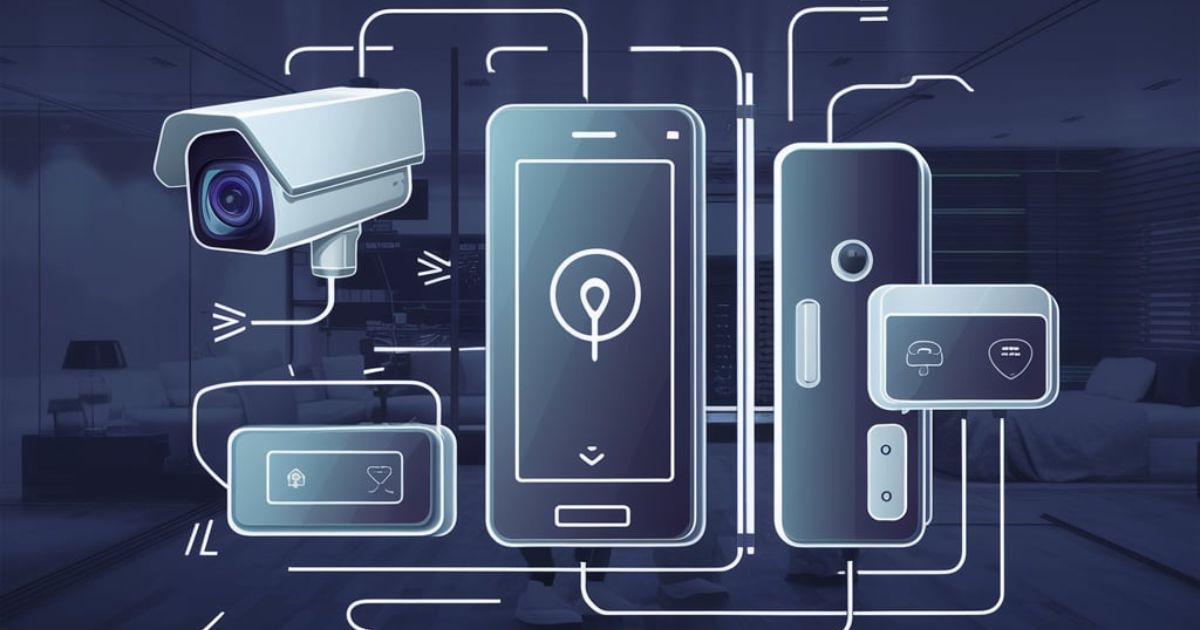In an age where technology is reshaping our daily lives, smart home security systems have emerged as a game-changer for American homeowners. But how does a smart home security system work, and why should you consider one for your home?
Let’s dive into the world of intelligent home protection and uncover the mechanics behind these cutting-edge systems.
What is a Smart Home Security System?
At its core, a smart home security system is a network of integrated devices that work together to protect your home. Unlike traditional security setups, these systems leverage internet connectivity and smart technology to offer unprecedented control and monitoring capabilities.
A typical smart home security system might include:
- Smart cameras
- Door and window sensors
- Motion detectors
- Smart locks
- Video doorbells
- A central control hub
What sets these systems apart is their ability to communicate with each other and with you, the homeowner, through your smartphone or other connected devices. For more insights and detailed information, visit Homifusion. This interconnectedness is the key to understanding how smart home security systems function.
Core Components of Smart Home Security Systems
Let’s break down the main components that make up a smart home security system:
- Smart Cameras: These aren’t your grandpa’s security cameras. Modern smart cameras offer high-definition video, night vision, and even AI-powered person detection. They can send alerts to your phone when they detect motion or unusual activity.
- Door and Window Sensors: These small devices alert you when a door or window is opened. They’re crucial for detecting unauthorized entry.
- Motion Detectors: These sensors can detect movement inside your home when the system is armed, triggering an alert or alarm.
- Smart Locks: Forget about hiding a key under the doormat. Smart locks allow you to lock and unlock your doors remotely, and even grant temporary access to visitors or service providers.
- Video Doorbells: These devices let you see and speak with visitors at your door, even when you’re not home.
- Control Hub: This is the brain of your smart home security system, coordinating all the other components and connecting them to your home network and smartphone.
How Smart Home Security Systems Function
Now that we’ve covered the components, let’s explore how a smart home security system works in practice.
Connectivity is Key
Smart home security systems rely on wireless protocols to communicate. The most common are:
- Wi-Fi
- Z-Wave
- Zigbee
These protocols allow your devices to talk to each other and to the central hub. The hub, in turn, connects to your home’s internet router, enabling remote access and control.
Central Hub Coordination
The control hub is the maestro of your smart home security orchestra. It receives signals from all your sensors and cameras, processes this information, and decides when to send alerts or trigger alarms.
Real-time Monitoring and Alerts
One of the most powerful features of smart home security is real-time monitoring. Whether it’s a door opening when you’re away, or motion detected in your living room at night, your system can instantly alert you via your smartphone app.
Remote Access and Control
Perhaps the most revolutionary aspect of smart home security is the ability to control and monitor your system from anywhere in the world. Forgot to arm your system when you left for vacation? No problem. Just pull out your phone and tap a button.
Key Features of Smart Home Security Systems
Smart home security systems offer a range of features that go beyond basic protection:
- 24/7 Professional Monitoring: Many systems offer the option of professional monitoring. If an alarm is triggered, a monitoring center is notified and can dispatch emergency services if needed.
- DIY Monitoring: For those who prefer to handle things themselves, most systems allow for self-monitoring through smartphone apps.
- Customizable Alerts: You can often customize what types of alerts you receive and how you receive them (text, email, push notification, etc.).
- Voice Assistant Integration: Many systems can be controlled via popular voice assistants like Alexa or Google Home.
- Geofencing: Some systems can automatically arm or disarm based on your phone’s location, ensuring you never forget to secure your home.
“Smart home security isn’t just about protection—it’s about peace of mind and convenience,” says John Smith, a home security expert. “It’s knowing your home is safe, even when you’re not there.”
Smart Home Security in Action
To better understand how smart home security systems work, let’s look at a few scenarios:
Scenario 1: Detecting an Intruder
- A window sensor detects that a window has been opened at 2 AM.
- The sensor sends a signal to the control hub.
- The hub triggers the alarm and sends an alert to your phone.
- If you have professional monitoring, the monitoring center is notified.
- You can use your app to view live footage from your security cameras.
- Based on what you see, you can choose to dismiss the alert or contact the authorities.
Scenario 2: Managing Access for Guests
- Your in-laws are visiting while you’re at work.
- Using your smartphone app, you disarm the system and unlock the front door.
- Once they’re inside, you re-arm the system and re-lock the door.
- Your smart cameras let you check in and ensure they’ve arrived safely.
Benefits and Considerations
While smart home security systems offer numerous benefits, there are also some factors to consider:
| Benefits | Considerations |
| Enhanced safety | Initial costs and ongoing fees |
| Remote access and control | Privacy concerns |
| Potential insurance discounts | Dependence on internet connectivity |
| Integration with other smart home devices | Potential for false alarms |
| Increased property value | Learning curve for setup and use |
Choosing the Right Smart Home Security System
When selecting a smart home security system, consider the following:
Your specific needs: Do you need outdoor cameras? How many entry points need to be monitored? Budget: Consider both upfront costs and any ongoing fees. Compatibility: Ensure the system works with your existing smart home devices. Professional vs. DIY installation: Some systems require professional installation, while others are designed for easy DIY setup. Monitoring options: Decide whether you want professional monitoring or if you’re comfortable with self-monitoring.
Some popular smart home security providers in the USA include Ring, SimpliSafe, and ADT. For those interested in celebrity homes, you might also want to look into MORGAN WALLEN HOUSE IN NASHVILLE. Research and compare their offerings to find the best fit for your needs.
The Future of Smart Home Security
As technology continues to advance, we can expect smart home security systems to become even more sophisticated. Some trends to watch for include:
AI and machine learning integration: Systems that can learn your habits and adjust accordingly. Improved sensors and cameras: Better quality video and more accurate detection capabilities. Enhanced integration with smart city initiatives: Your home security system could potentially connect with broader city-wide security networks.
Conclusion
Understanding how smart home security systems work is the first step towards enhancing your home’s safety in the digital age. These systems offer unprecedented control, convenience, and peace of mind. While there are considerations to keep in mind, the benefits of smart home security are clear.
As you explore your options, remember that the best system is one that fits your specific needs and lifestyle. Whether you’re tech-savvy or a smart home novice, there’s a solution out there that can help you feel safer and more connected to your home than ever before.
Embrace the future of home security with smart technology. Your safer, smarter home awaits!
Keep an eye for more news & updates on Internalinsider.com.










